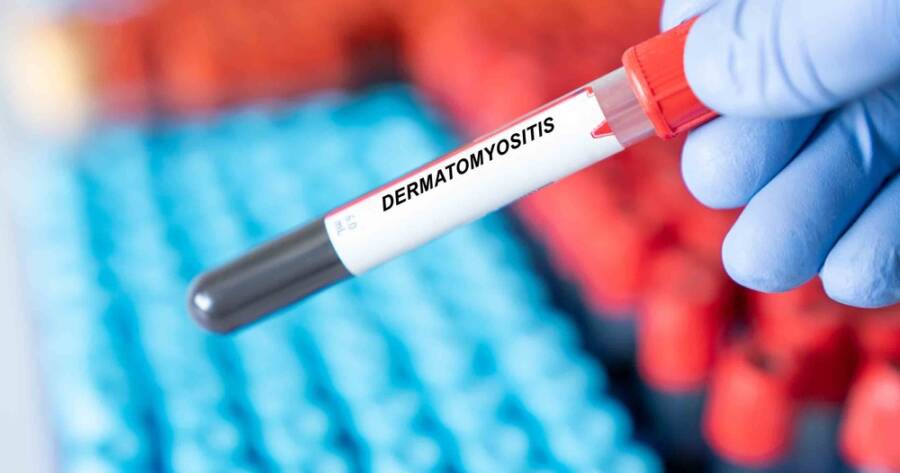Dermatomyositis is a rare inflammatory disease that affects both the skin and muscles. Its hallmark signs include muscle weakness and a distinctive skin rash, often appearing on the face and knuckles. Early detection can help manage its symptoms and improve quality of life.
Understanding Dermatomyositis
Dermatomyositis is an inflammatory disease that targets the body’s muscles and skin. The cause of this condition is still not fully understood, but it is thought to involve an autoimmune response. In this case, the immune system attacks healthy tissue by mistake. Some researchers also believe that infections or certain cancers might trigger this disease in certain people.
There is no known cure for dermatomyositis, but early treatment can help control the symptoms. Common therapies include medication, physical therapy, and regular monitoring. Understanding the signs and symptoms can help individuals seek help before the condition worsens.
Muscle Weakness: A Key Symptom
One of the most common signs of dermatomyositis is muscle weakness. This weakness typically affects large muscle groups like the shoulders, hips, and thighs. It often begins gradually, causing difficulty with activities such as climbing stairs, getting up from a chair, or even lifting the arms above the head. The weakness tends to worsen over time if untreated, making daily tasks more challenging.
Muscle weakness in dermatomyositis usually develops on both sides of the body. It is essential to recognize this symptom early, as untreated muscle weakness can lead to muscle wasting or damage, which may be difficult to reverse.
Skin Changes: The Hallmark of Dermatomyositis
In addition to muscle problems, dermatomyositis often causes noticeable changes in the skin. One of the most distinct signs is a reddish rash that typically appears on the eyelids, face, knuckles, elbows, knees, and chest. The rash can be itchy, painful, or both.
Another common skin symptom is the development of Gottron’s papules. These are raised, scaly bumps that form over the knuckles or joints. The skin may become more sensitive to sunlight, leading to further irritation and redness in areas exposed to the sun.
Skin changes in dermatomyositis can range from mild to severe, but they are often one of the first clues that someone may have this condition. If you notice unusual or persistent rashes along with muscle weakness, it’s important to seek medical advice.
Joint Pain and Swelling
While dermatomyositis primarily affects the muscles and skin, it can also cause joint problems. Many people with the condition experience joint pain and swelling, similar to arthritis. The joints in the hands, wrists, knees, and feet are often most affected.
Joint pain caused by dermatomyositis can be mild or severe, making movement uncomfortable. In some cases, joint swelling can also occur, which may limit the range of motion. Although this symptom is less common than muscle weakness and skin changes, it can be a sign that dermatomyositis is present.
Difficulty Swallowing and Breathing
Another significant symptom of dermatomyositis is difficulty swallowing, known as dysphagia. The muscles involved in swallowing can weaken, making it harder to eat or drink. This symptom can lead to unintended weight loss or malnutrition if not addressed.
In more severe cases, dermatomyositis can affect the muscles used for breathing. When the respiratory muscles weaken, it may become difficult to breathe, especially during physical activity. If left untreated, this can lead to respiratory failure, which is a life-threatening complication. Anyone with dermatomyositis who notices trouble breathing should contact a doctor right away.
Fatigue and Fever
Fatigue is a common symptom that can affect individuals with dermatomyositis. The body’s immune response to inflammation can cause exhaustion, making it difficult to carry out daily tasks. People with dermatomyositis often feel tired even after getting plenty of rest.
Fever can also accompany dermatomyositis, especially in the early stages of the disease. Although fever is not always present, it can indicate the body is fighting off inflammation. If you experience muscle weakness, rashes, and a low-grade fever, it may be time to see a healthcare professional.
How Is Dermatomyositis Diagnosed?
Dermatomyositis can be challenging to diagnose because its symptoms resemble those of other conditions. A doctor will usually start with a physical exam, reviewing the patient’s medical history and symptoms. If dermatomyositis is suspected, several tests may be used to confirm the diagnosis. These include blood tests to detect elevated muscle enzymes, skin or muscle biopsies, and imaging tests like MRI scans. Sometimes, an electromyogram (EMG) is used to measure the electrical activity of muscles, helping to determine the extent of muscle damage.
Early diagnosis is crucial for managing dermatomyositis. The sooner the condition is identified, the better the chances of controlling its symptoms and preventing further complications.
Managing Dermatomyositis
While dermatomyositis is a rare and often challenging condition, early detection and proper treatment can make a significant difference in managing the symptoms. By recognizing the key signs like muscle weakness, skin rashes, and joint pain, individuals can seek medical care before the condition worsens.
Ongoing treatment and support can help patients maintain their strength and improve their quality of life. Regular medical checkups, physical therapy, and medications can help manage the condition and keep it from progressing too quickly.
It is always essential to consult a healthcare provider if you experience symptoms of dermatomyositis. A personalized treatment plan can help minimize the effects of the disease and improve your overall well-being.
